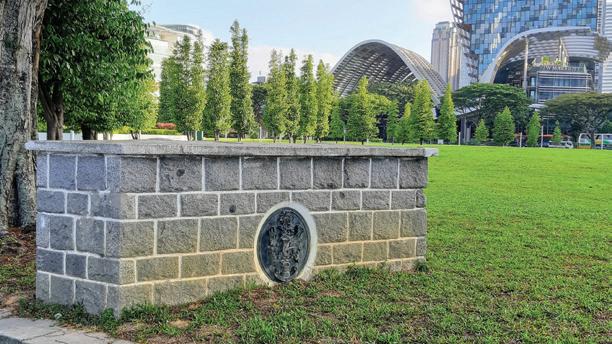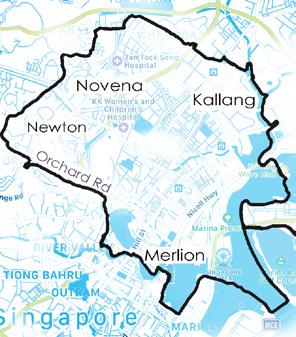
4 minute read
Exploring Singapore
observations of an expat in Singapore
Paying a Visit to Esplande Park
Advertisement
Written by and Photography by Amanda Jaffe
Wedged between the Padang’s classic green and the durian-spiked Theaters on the Bay, Esplanade Park and its surroundings are filled with monuments and memorials that invite you to join in some of Singapore’s collective memories. It’s worth your time to accept the invitation and pay a visit.
The Esplanade Park Memorials
Three memorials sit at the heart of Esplanade Park: Tan Kim Seng Fountain and Lim Bo Seng Memorial at either end and the Cenotaph in the middle. It’s not often that you find monuments commemorating the contributions of individuals in Singapore. There’s something wonderfully Singaporean in the fact that these three memorials were designated collectively as a single National Monument in 2010. Tan Kim Seng Fountain resides at the park’s Stamford Road end. This beautiful cast iron fountain, constructed in 1882, features four Muses, faces of Poseidon, and cupids. The inscription around the base commemorates Tan Kim Seng’s 1857 donation toward the construction of public waterworks for the city of Singapore. A leader of Singapore’s Chinese community, Tan Kim Seng founded two educational institutions and was a leading supporter of Singapore’s Chinese Pauper Hospital (today’s Tan Tock Seng Hospital). Modelled on the Cenotaph in Whitehall, London, Singapore’s Cenotaph sits, solemn and austere, in the middle of Esplanade Park. Completed in 1922 and unveiled by the Prince of Wales, Edward VIII, it was built to honor the 124 men from Singapore who died in World War I. On the side facing the Padang,
View from the mouth of the Singapore River five steps leading to the monument list the five years of World War I, and bronze tablets list the names of the dead. In 1950, the Cenotaph’s base was expanded to commemorate World War II casualties on the reverse. This side of the Cenotaph is inscribed, “They died that we might live” in Singapore’s four official
The Struggle Against the Communist Party of Malaya Marker

languages. The steps list the years 1939 through 1943, with 1944 and 1945 inscribed on the base. At the other end of Esplanade Park, you’ll find the Lim Bo Seng Memorial, the only Singapore memorial to honor an individual’s sacrifice during World War II. Long active in anti-Japanese war efforts, Lim Bo Seng fled Singapore shortly before Japan invaded for Malaya, where he built a resistance group known as Force 136. Lim Bo Seng was captured by the Japanese and died in a prison camp in 1944. The memorial, unveiled on the tenth anniversary of his
The Cenotaph death, features an eight-sided pagoda with bronze roof, four bronze lions, and plaques honoring Lim Bo Seng in Chinese, Malay, English and Tamil.
Near the Cenotaph
Not far from the Cenotaph, another memorial recalls Singapore’s struggle against the Communist Party of Malaya, which sought to establish a communist regime in Malaysia and Singapore from 1948 until 1989. A nearby historical marker recalls a memorial erected near the end of the Japanese occupation to honor the Indian National Army (INA). Starting in 1942, Japan encouraged -- in some cases forced Stamford Bridge Pier -- prisoners-of-war from the British Indian Army to join the INA to fight for Indian independence. Lord Mountbatten ordered the memorial destroyed when he returned to Singapore in 1945.
Around Lim Bo Seng Memorial
Near the Lim Bo Seng Memorial, five Angsana trees recall Gor Zhang Chiu Kar, Hokkien for “under the shade of five trees.” This was a popular dating spot from the 1960s until the 1980s. When the original trees became diseased in the early 1990s, they were replaced by five mature Angsanas brought from Upper Serangoon Road. Take a moment to admire The Rising Moon, by Han Sai Por and Kum Chee Kiong. Installed in 2015, this granite and steel construction with accompanying boulders reinterprets the five stars and crescent moon of Singapore’s flag and pays tribute to the Singapore River. Spend a few minutes surveying the mouth of the Singapore River from Queen Elizabeth Walk. Originally a seaside promenade, the walk was named in honor of Queen Elizabeth’s coronation in 1953. Then head toward Anderson Bridge and take the underpass (Singapore’s first, from 1964!) to Empress Place, named in honor of Queen Victoria. Here, you’ll find colonial-era monuments in the form of the Dalhousie Obelisk (erected in 1850) and the original statue of Sir Stamford Raffles (unveiled in 1887).
Near Tan Kim Seng Fountain
From Tan Kim Seng Fountain, cross Stamford Road to visit and reflect at War Memorial Park. Rising in the park’s center, the four columns of Singapore’s Civilian War Memorial commemorate the shared wartime experiences of Singapore’s four main ethnic groups. In a corner of the park near the intersection of Stamford Road and Esplanade Drive, you’ll find the remnants of Stamford Bridge, which used to cross the now-covered Stamford Canal. While not a memorial, they remind us that there are many ways,



big and small, to connect with Singapore’s past.
Tan Kim Seng Fountain

In addition to exploring Singapore for Bamboo Telegraph, Amanda Jaffe writes about her travel adventures on her blog, Rambling Llama (www.ramblingllama.com).



